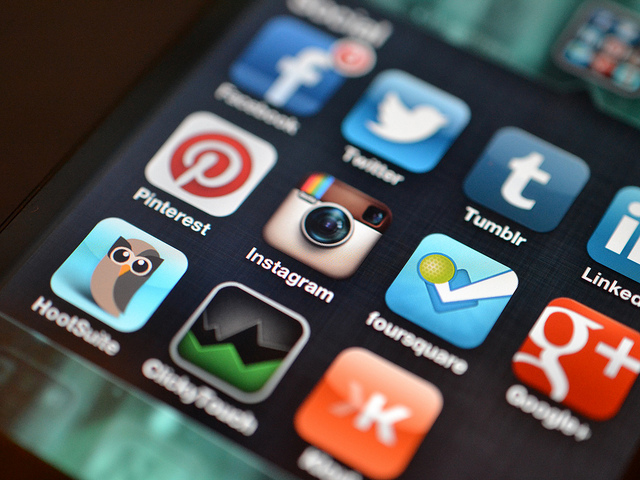Take a moment to remember your first cell phone. Mine was a blue LG env3 flip phone that was virtually indestructible and had a mysterious internet button that I was never allowed to press. In 7th grade, this was the epitome of freedom; all of a sudden, I had the power to text or call whomever, wherever, and whenever I wanted—and I had never felt more connected.
Today, social media and the internet have given the term “connected” a completely different meaning. We can constantly track our friends’ whereabouts with Snapchat, set up dates with complete strangers over Tinder, and Google anything we want to know within seconds. I had not thought about what life was like before this era of extreme connection, until I recently came across an ad for the Light Phone while scrolling through Facebook. Unlike other smartphones on the market today, the Light Phone is described as a quite smart “dumb phone.” The Light Phone syncs with your current iPhone and provides a minimalist option for daily use; it can make calls, send texts, set the occasional alarm, and read simple directions. Other than that, it has none of the features that most people expect from their phones today, such as social media applications or internet access.
Co-creators Joe Hollier and Kai Tang founded their company Light in 2014 after meeting at a Google incubator. The two connected over their mutual disinterest for creating more addicting smartphone applications and eventually decided to quit their jobs and create a phone “intended to be used as little as possible,” in order to get people off of their smartphones and reengaged with the real world.[1]
Your first reaction to this proposal may be to roll your eyes at the implication that smartphones and social media are an addictive menace to society. As a 19-year-old college student who is leading an overall productive life despite my near constant connection to my phone, I initially dismissed this as the same tired argument perpetrated by members of an older, less tech-savvy generation. However, considering the Light Phone has been sold over 10,000 times in more than 50 countries already, I wondered if their message was worth a second look.[2]
Since the meteoric rise of smartphone technology, social media and internet applications have accounted for a large block of the five hours the average American spends daily on their mobile device.[3] It is impossible to argue that platforms like Twitter, Instagram, and Facebook have not completely reshaped the way we consume entertainment, news, and even the way we interact with one another. But why should the integration of social media into our society be a cause for concern?
Major technological advancements have always created mass “moral panic” throughout history. In the 1920’s, the boogeyman invention that was believed to be dumbing down children and shortening people’s attention span was the radio. When the railroads were built, some people even argued that women should not travel on trains, for the fear that “speeds of more than 50 miles per hour could cause the uterus to fly out of the body.”[4] Genevieve Bell, a professor at Australia’s National University College of Engineering and Computer Science, said in an interview with the Wall Street Journal that any new technology that drastically changes our lives and how we spend our time is likely to require an adoption period, which can trigger social anxiety and unrest.[5]
In that case, what makes smartphones, and specifically social media applications, any different?
Unlike other commodities like TV sets or radios, the business behind social and interactive media itself is only profitable if it is addictive. Sites like Facebook, Twitter, Instagram, and even Google have little to no entry costs and are therefore reliant on consumer usage rates in order to make money. Behind these products, which offer us unimaginable access to information and each other, are companies that are competing to control our limited attention. And in order to outperform one another, many of their products are consciously designed in order to appeal to our psyches and keep us engaged.
Tristan Harris, an ex-design ethicist at Google, claims technology platforms have psychological strategies implemented in order to exploit and profit off of people’s innate tendencies and vulnerabilities. However, because social media creates a personalized user experience, the consumer retains their illusion of independence and conscious decision making over what content they consume, where they consume it, and for how long.
Harris argues that if the average person checks their phone 150 times a day, they are not making 150 individual, well-informed choices to do so every time.[6] Even I can admit that while writing this article, I found myself stopping to check my Twitter feed at least a few times as a “mental break.” This begs the question, what aspects of social media compel us to stop other activities and use our phones at such an outstanding rate?
Notifications are a huge part of social media platforms’ effort to keep you constantly engaged, even when you are not using the app. The sense of FOMO (“fear of missing out”) that is created when you are always being interrupted by alerts and messages makes it difficult to actively pursue other activities without taking breaks to check your phone.
Another major technique to get people to continually check their apps is the same premise used in slot machines. The process of linking someone’s action to a variable reward will greatly increase the addictiveness of the product. This is a psychological effect known as the intermittent variable reward, and it works whether the user is pulling a lever at a Las Vegas casino, or swiping to refresh their timeline.[7] In both situations, the user is taking a chance and hoping for a certain variable outcome, whether it be money or interesting content and news.
It is common knowledge that social media can exploit our desire for approval from our peers. Studies have shown that being active on social media can trigger dopamine releases in our brain similar to releases caused by exercise or accomplishing a goal.[8] For example, when we receive a “like” on an Instagram post, the platform has helped us feel a sense of belonging or connection, which makes us feel good about ourselves. However, even Justin Rosenstein, the Facebook engineer who created the “like” button, recently compared the feature to “bright dings of pseudo-pleasure that can be as hollow as they are seductive.”[9] Rosenstein is now an outspoken critic of what he perceives to be our new “attention economy” and its impact on our ability to focus and social interactions.
Another important tool that media sites such as Netflix, Youtube, and Facebook use is the autoplay feature. News and media feeds are purposely designed to keep you scrolling, and try to eliminate any reason for you to pause or leave. Notably, a huge portion of traffic on these websites is a direct outcome of this autofill feature.
“Tech companies often claim that ‘we’re just making it easier for users to see the video they want to watch’ when they are actually serving their business interests,” said Harris. “And you can’t blame them, because increasing ‘time spent’ is the currency they compete for.”[10]
Furthermore, the lack of social responsibility felt by companies that produce smartphones or social media apps is a huge issue when thinking about the implications of how these addictive features can impact societal behavior. Nir Eyal, author of “Hooked: How to Build Habit-forming Products” argues that smartphones themselves are not “addictive” as long as companies are designing “ethical” habit-forming products.[11] However, the reality is many of these companies are driven by profit, and have little incentive to care about the negative effects that their products have on society, which unfortunately are becoming more and more apparent.
Though this technology has only existed for a few years, the psychological harms of smartphone applications and social media are already well-documented. Studies have shown a positive correlation between social media use and feelings of loneliness or isolation.[12] Equating their online network’s carefully curated presentation of their lives with reality ultimately makes people feel insufficient and leads to more cases of depression.[13]
This has become a huge issue among the teenage girl demographic, which dominates platforms such as Instagram and Snapchat.[14] A 2017 study revealed that girls who spent the most time using technology were most likely to say they were sad or depressed. They were also more likely to want to change their appearance, not enjoy coming to school, and not participate in other activities.[15]
Also, it can be argued that our brains are not fundamentally equipped to process this constant stimuli. Visiting the slot machines for a few hours is one thing, but being continuously engaged with the highs and lows of the variable reward system has actual cognitive consequences, which includes a constant “background hum of anxiety” for many people. A huge case study for this is currently on college campuses worldwide, where mental health experts confirm the rise of constant smartphone and social media use among students has led to a wave of anxiety-related disorders on campuses.[16]
The most shocking thing about the debate surrounding the negative impact of smartphones and social media is that the countermovement is being led by the very people who created it. A 2017 survey conducted by the Silicon Valley Community Foundation found that despite high confidence in the benefits of technology, many parents with jobs based in Silicon Valley now have serious concerns about technology’s impact on their children’s psychological and social development.[17]
“You can’t put your face in a device and expect to develop a long-term attention span,” said Taewoo Kim, chief AI engineer at the One Smart Lab during an interview with Business Insider.[18]
Many parents like Kim raise their children with an appreciation for games and activities that do not require devices, and some even participate in family tech-free silent retreats.
“The tech companies do know that the sooner you get kids, adolescents, or teenagers used to your platform, the easier it is to become a lifelong habit,” Kim told Business Insider, citing Google’s push into schools with programs such as Google Docs, Google Sheets, and Google classroom as anything but coincidental.[19]
Turning children into loyal consumers is a common strategy for many unhealthy or addictive industries; the major tobacco companies alone are estimated to spend nearly $9 billion a year marketing their products in places that kids might be exposed to.[20] And though Google may not view its product as a danger to children like cigarettes, that does not negate how the addictive aspects of their platforms are proving to have harmful and lasting impressions.
“It is very common for humans to develop things with the best of intentions that have unintended, negative consequences” said Rosenstein.[21]
In addition to products like the Light Phone, other mass efforts to counteract unhealthy consumption of social media include the formulation of activist groups that want to hold companies accountable. A group called Stanford Students Against Addictive Devices that originated in Stanford University’s Computer Science department has scrutinized and protested Apple for being a “gateway to addictive services like Facebook and company”[22] and not taking precautionary measures to fight phone addiction.
Apple released a statement in January 2018 with plans for new parental features that can restrict phone use among young people, though SAADD has other recommendations that go further. One of these includes the demand for Apple to offer an “essential mode” on all of its phones that would limit the iPhone to three tasks: call, text, and photos. The group also recommend that users turn their social media notifications off and use their phone in gray mode to “minimize dopamine hits.”[23]
Both innovative new products and putting pressure on companies are important, but the first step in combating the issue around how we use social media and smartphones is to acknowledge that the problem exists and that it may be seriously impacting our mental and social well-being more than we realize.
[1] Hartmans, Avery. “This beautifully designed ‘dumb phone’ can only make calls and send texts – and it might be the key to curing our addiction to apps.” Business Insider. March 01, 2018. Accessed March 08, 2018 http://www.businessinsider.com/light-phone-2-cure-for-app-addiction-2018-2
[2] Ibid.
[3] Ibid.
[4] Oreskovic, Alexei. “Confessions of a screen addict: I wake up at 2 a.m. every morning to use my phone and I’m a little worried.” Business Insider. February 17, 2018. Accessed March 08, 2018 http://www.businessinsider.com/confessions-of-a-screen-addict-introduction-to-the-your-brain-on-apps-series-2018-2
[5] Ibid.
[6] Harris, Tristan “How Technology Hijacks People’s Minds - from a Magician and Google’s Design Ethicist” May 6, 2016. Accessed March 08, 2018 http://www.tristanharris.com/2016/05/how-technology-hijacks-peoples-minds%E2%80%8A-%E2%80%8Afrom-a-magician-and-googles-design-ethicist/
[7] Ibid.
[8] Sort, Molly. “Social Media Triggers a Dopamine High.” AMA.org. November 2015. Accessed March 08, 2018 https://www.ama.org/publications/MarketingNews/Pages/feeding-the-addiction.aspx
[9] Lewis, Paul. “‘Our minds can be hijacked’: the tech insiders who fear a smartphone dystopia.” The Guardian. October 06, 2017. Accessed March 08, 2018 https://www.theguardian.com/technology/2017/oct/05/smartphone-addiction-silicon-valley-dystopia
[10] Ibid.
[11] Oreskovic. “Confessions of a screen addict: I wake up at 2 a.m. every morning to use my phone and I’m a little worried.”
[12] “Dr. Cal Newport: Quit Social Media at TEDxTysons (Full Transcript).” The Singju Post. January 13, 2017. Accessed March 08, 2018 https://singjupost.com/dr-cal-newport-quit-social-media-at-tedxtysons-full-transcript/
[13] Ibid.
[14] Lenhart, Amanda. “Teens, Social Media & Technology Overview 2015.” Pew Research Center: Internet, Science & Tech. April 08, 2015. Accessed March 08, 2018 http://www.pewinternet.org/2015/04/09/teens-social-media-technology-2015/
[15] Simmons, Rachel. “Teenage girls are facing impossible expectations.” CNN. February 27, 2018. Accessed March 08, 2018 https://www.cnn.com/2018/02/27/opinions/girls-power-expectation-depression-opinion-simmons/index.html
[16] Harris. “How Technology Hijacks People’s Minds - from a Magician and Google’s Design Ethicist”
[17] Weller, Chris. “Silicon Valley parents are raising their kids tech-free – and it should be a red flag.” Business Insider. February 18, 2018. Accessed March 08, 2018 http://www.businessinsider.com/silicon-valley-parents-raising-their-kids-tech-free-red-flag-2018-2
[18] Ibid.
[19] Ibid.
[20] Ibid.
[21] Lewis. “‘Our minds can be hijacked’: the tech insiders who fear a smartphone dystopia.”
[22] Leswing, Kif. “We talked to the Stanford students who protested Apple over smartphone addiction – and Apple employees are into their ideas.” Business Insider. March 07, 2018. Accessed March 08, 2018 http://www.businessinsider.com/qa-stanford-apple-iphone-less-addictive-2018-3
[23] Ibid.



